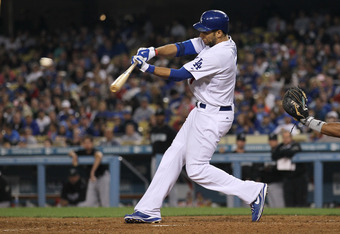
James Loney swinging his "big stick" at Dodger Stadium.
Stephen Dunn/Getty Images
Stephen Dunn/Getty Images
The RBI (run batted in) is a major stat in baseball, but fans and experts debate whether it is meaningful in determining a player’s offensive worth.
Former National League MVP second baseman Jeff Kent has his own motto about the importance of the run batted in.
"The money lies in the RBIs," Kent said to Comcast Sportsnet Bay Area in a 2009 interview.
James Loney of the Los Angeles Dodgers is a good example of the debate. In 2010, Loney batted just .261 with 10 home runs, but had 88 RBIs.
Were Loney’s 88 RBIs an indication of a solid contribution with the stick or were they just a product of him hitting with many ducks on the pond?
Baseball experts seem to disagree, and no right or wrong answer seems to exist.
Mike Petriello, a prominent Dodger blogger and creator of the blog “Mike Scioscia’s Tragic Illness,” says that RBIs have no connection to how well a player can swing the bat, as they are too dependent on whether the batters before him reach base.
“The whole point of stats is that they're supposed to show what a player did, and numbers like RBI (and pitcher wins) have too much noise from the influence of other players,” Petriello said.
Mychael Urban, a baseball insider for CSNBayArea, disagrees with Petriello and believes that a run-producer is a valuable asset to any team.
“Anyone who ignored the importance of driving in runs is asinine,” Urban wrote on Twitter.
Both sides of the coin may have some merit.
Ken Rosenthal, Senior Baseball Writer for Fox Sports, suggests that an argument can be made for both sides, but other baseball statistics are better indicators of a hitter's ability.
“There is a real difference of opinion on this (on RBIs measuring a player’s offensive worth),” Rosenthal wrote on Twitter. “I say yes, stat has some value, but OBP/SLG mean more.”
Rosenthal’s assessment seems to make the most sense. Although the RBI statistic does not paint a complete picture in determining a player’s offensive worth, it does have an important value.
It takes some sort of hitting talent to drive in runners, regardless of how often people are on base when a player comes up or the team on-base percentage. Anyone who watched the 2009 Giants could clearly see the importance of a consistent RBI-producer.
The 2009 Giants often stranded runners on third with less than two outs. They could not get any runners in, no matter who was on base or how often men were on base. The Giants routinely squandered these golden opportunities.
James Loney was good at getting those runners in. He was able to take advantage of those situational at-bats, even when an out would produce a run.
Unlike most of the 2009 Giants lineup, he had the concentration and hitting ability to get a good pitch to drive to the outfield with runners at third and less than two outs. He could get that RBI hit when it mattered. He could get that RBI ground out with the infield back.
Sometimes the little things—e.g., the manufactured RBI—are what win ball games.
They may not be impressive, but they are just as important. The Giants improved their situational hitting drastically in 2010 and look what happened—they won a championship.
Loney only had 10 home runs, but that does not mean he is a bad hitter. In order to get 88 RBIs with such little power, he had to be a smart situational hitter, trading an out for a run if necessary. He had to hit doubles and get those base hits with runners in scoring position.
Loney is a gap-to-gap Mark Grace-type hitter. He was fifth in the National League in doubles with 41, which might have been a contributing factor toward the solid RBI total.
Regardless of his little power at a power position, Loney demonstrated enough competence at the plate to deliver quality situational at-bats.
Take someone like the Dodgers’ new acquisition Eugenio Velez and ask him to do the same thing Loney did, given that he has the same chances with runners on base as Loney did.
Would he be competent enough to reach 88 RBIs?
He would chase too many pitches out of the strike zone and would either strike out or pop out. He just does not have the offensive ability to do what Loney does on a consistent basis.
Although driving in runs is just one dimension in assessing a hitter’s offensive ability, it is an important one that cannot be ignored. Of course, a player’s batting average, slugging percentage, on-base percentage, home run total, .OPS and sabermetric statistics should also be examined when assessing a player’s offensive ability.
Still, someone who can drive in runs, but lacks in other offensive categories still brings something valuable to the table—he can bring in runs when the situation calls for it.
Every team needs someone like this to win, but to determine if someone is a great hitter requires looking at more of his numbers.
Time to get out that book on advanced statistics.
No comments:
Post a Comment